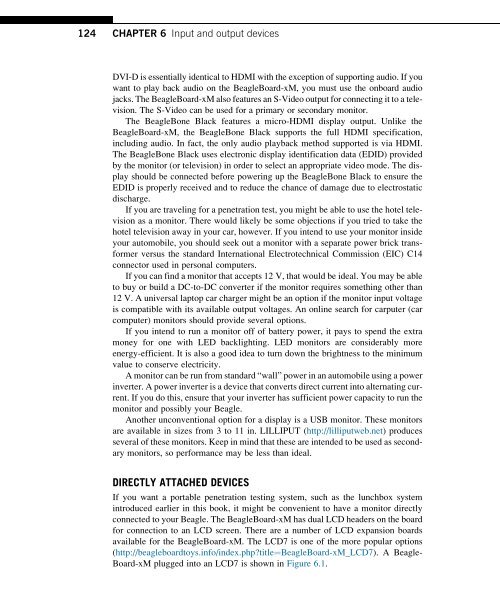Hacking_and_Penetration_Testing_with_Low_Power_Devices
Create successful ePaper yourself
Turn your PDF publications into a flip-book with our unique Google optimized e-Paper software.
124 CHAPTER 6 Input <strong>and</strong> output devices<br />
DVI-D is essentially identical to HDMI <strong>with</strong> the exception of supporting audio. If you<br />
want to play back audio on the BeagleBoard-xM, you must use the onboard audio<br />
jacks. The BeagleBoard-xM also features an S-Video output for connecting it to a television.<br />
The S-Video can be used for a primary or secondary monitor.<br />
The BeagleBone Black features a micro-HDMI display output. Unlike the<br />
BeagleBoard-xM, the BeagleBone Black supports the full HDMI specification,<br />
including audio. In fact, the only audio playback method supported is via HDMI.<br />
The BeagleBone Black uses electronic display identification data (EDID) provided<br />
by the monitor (or television) in order to select an appropriate video mode. The display<br />
should be connected before powering up the BeagleBone Black to ensure the<br />
EDID is properly received <strong>and</strong> to reduce the chance of damage due to electrostatic<br />
discharge.<br />
If you are traveling for a penetration test, you might be able to use the hotel television<br />
as a monitor. There would likely be some objections if you tried to take the<br />
hotel television away in your car, however. If you intend to use your monitor inside<br />
your automobile, you should seek out a monitor <strong>with</strong> a separate power brick transformer<br />
versus the st<strong>and</strong>ard International Electrotechnical Commission (EIC) C14<br />
connector used in personal computers.<br />
If you can find a monitor that accepts 12 V, that would be ideal. You may be able<br />
to buy or build a DC-to-DC converter if the monitor requires something other than<br />
12 V. A universal laptop car charger might be an option if the monitor input voltage<br />
is compatible <strong>with</strong> its available output voltages. An online search for carputer (car<br />
computer) monitors should provide several options.<br />
If you intend to run a monitor off of battery power, it pays to spend the extra<br />
money for one <strong>with</strong> LED backlighting. LED monitors are considerably more<br />
energy-efficient. It is also a good idea to turn down the brightness to the minimum<br />
value to conserve electricity.<br />
A monitor can be run from st<strong>and</strong>ard “wall” power in an automobile using a power<br />
inverter. A power inverter is a device that converts direct current into alternating current.<br />
If you do this, ensure that your inverter has sufficient power capacity to run the<br />
monitor <strong>and</strong> possibly your Beagle.<br />
Another unconventional option for a display is a USB monitor. These monitors<br />
are available in sizes from 3 to 11 in. LILLIPUT (http://lilliputweb.net) produces<br />
several of these monitors. Keep in mind that these are intended to be used as secondary<br />
monitors, so performance may be less than ideal.<br />
DIRECTLY ATTACHED DEVICES<br />
If you want a portable penetration testing system, such as the lunchbox system<br />
introduced earlier in this book, it might be convenient to have a monitor directly<br />
connected to your Beagle. The BeagleBoard-xM has dual LCD headers on the board<br />
for connection to an LCD screen. There are a number of LCD expansion boards<br />
available for the BeagleBoard-xM. The LCD7 is one of the more popular options<br />
(http://beagleboardtoys.info/index.php?title¼BeagleBoard-xM_LCD7). A Beagle-<br />
Board-xM plugged into an LCD7 is shown in Figure 6.1.


